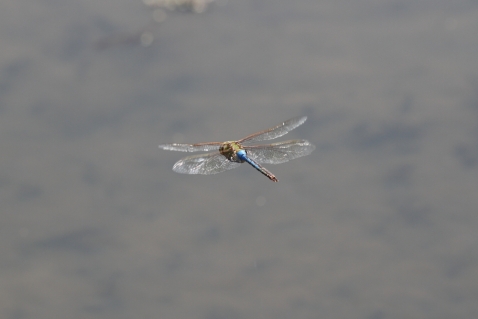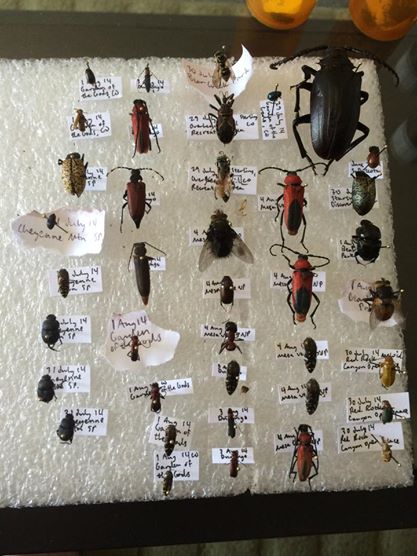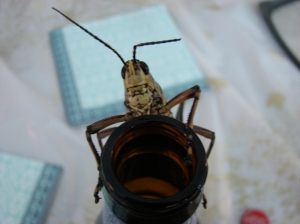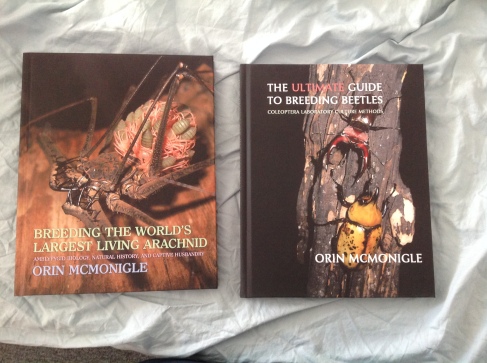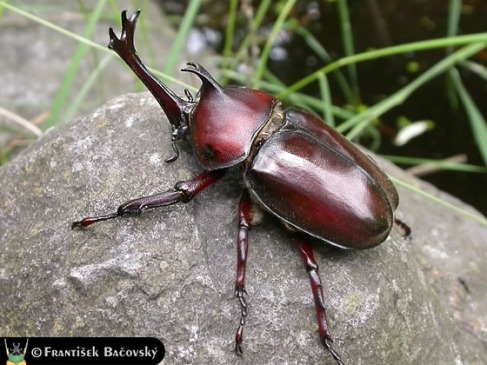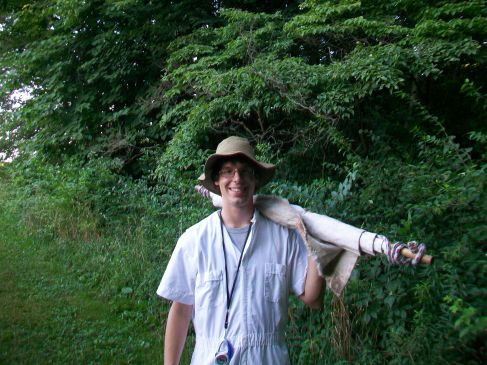Spring has Sprung!
After a rather odd winter, it seems that spring has finally arrived in central Illinois! Spring ephemeral plants are flowering and the insects have begun emerging in large numbers! Some of the things you may see are:
Common green darner (Anax junius) – this is an early migrating dragonfly species that you’ll commonly see around ponds and marshes. Look for a large dragonfly with a green body and green or blue abdomen. Warning to those wanting photographs, they never stay still! Hover shots will usually be what you get.
Butterflies such as the spring azure (Celastrina ladon), eastern comma (Polygonia comma), painted lady (Vanessa cardui), and mourning cloak (Nymphalis antiopa) can be found flying now, among many other species! I’m hoping with the warm weather this weekend to get out and photograph some of these!
For the grasshopper lover, the green-striped grasshopper (Chorthophaga viridifasciata) nymphs awoke from their winter slumber almost a month ago and finally begun molting to adulthood! This species overwinters in Illinois as late instar nymphs, meaning they have molted several times and are close to adulthood. After snacking on early spring vegetation, they were able to complete their final molts, and can be found in fields and along trails.
Even with the species I’ve listed here, it’s only touching the tip of the iceberg as more arthropods wake up and begin yet another season. Flies, bees, ants, cockroaches, beetles and more have begun to crawl about and are just out there waiting to be found.
Enjoy this spring weather, everyone! Hope you have a wonderful start to your arthropod season!
Keeping Live Invertebrates – Part II
A very short post on this page anyway because my most recent post has been featured on Entomology Hub! Very excited to have gotten this opportunity and hoping to do more work with them as time goes on.
Also, don’t forget that you can find me on Facebook and Twitter @damondiadema.
A Quick(ish) Post: An Update and My Arthropod Collection
Just wanted everyone to know that I’m still alive! I apologize for the lengthy disappearance but just wanted to catch everyone up on what has been happening since the last time.
Since the last post I’ve completed my Master’s degree and am now trying to get my work published (it will be split up into two manuscripts so there’s still lots of work ahead). I’m currently on the job boards trying to find a job, but the market is a little small at the moment. I have gotten a few interviews but nothing has panned out. There’s no need to despair though! I just need to keep applying to jobs and something will eventually work out. In the meantime though, I have been working as a field and lab technician in Dr. Sam Heads’ lab at the University of Illinois Urbana-Champaign where I have been helping survey prairie landscapes across Illinois to determine how land management techniques influence density and diversity of indicator insect species. The groups we have been looking at are:
Tiger beetles
Band wing grasshoppers
Cicadas
Butterflies
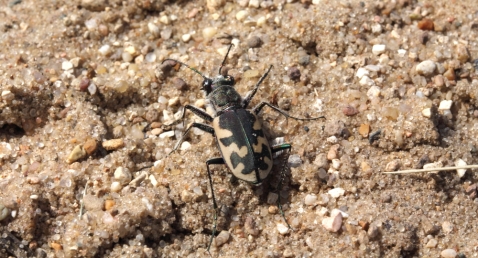
A handsome Cincindela formosa, the big sand tiger beetle
On the hobby front, I have taken up birding in the last few months to help me get through the winter weather. I’ve really enjoyed it though and plan on continuing once things warm up again. As for my pets, I have expanded significantly into roaches and widows. My goal is to own a very wide variety of widow species and successfully breed them too. Same goes for the smaller roach species, though I’ll likely get into hissing cockroaches and some of the larger species someday.
Here is my current list of pets. Before we get started though, I would like to explain what the numbers before each species means. It’s separated out into male.female.unsexed. So if you see a species that’s labeled as 0.0.1, that means that I have one unsexed individual. If there is an X where a number is, it means I have no idea how many individuals I have.
Tarantulas:
0.0.1 Avicularia metallica – Metallic pink toe
1.1.0 Brachypelma albiceps – Mexican golden red rump
0.0.1 Brachypelma albopilosum – Curly hair
0.0.3 Brachypelma emelia – Mexican red leg
1?0.1 Brachypelma smithi – Mexican red knee
0.0.4 Cyriocosmus elegans – Trinidad dwarf
0.0.2 Cyriocosmus perezmilesi – Bolivian dwarf beauty
0.0.1 Cyriocosmus ritae – Peruvian black and white
0.0.2 Grammostola rosea – Red rose hair
0.1.0 Hapalopus sp. Pumpkin Patch – Pumpkin patch
0.0.1 Hapalopus triseriatus – Lemon patch
0.0.2 Poecilotheria rufilata – Redslate ornamental
0.0.1 Psalmopoeus cambridgei – Trinidad chevron

Brachypelma albiceps– Mexican golden red rump
Scorpions:
0.0.1 Anuroctonus phaiodactylus – Mafia scorpion
0.0.3 Centruroides gracilis – Florida bark scorpion
0.1.1 Hadogenes sp. – Flat rock scorpion
0.0.4 Hoffmanius spinigerus – Striped tail scorpions
0.3.0 Liocheles australiasiae – Dwarf bark scorpion
1.1.0 Orthochirus scobiculosus negebensis – Pillar tail scorpion
0.0.1 Parabuthus schlecteri – no common name
1.0.0 Rhopalurus garridoi – no common name
2.1.7 Rhopalurus junceus – Caribbean blue scorpion
1.1.0 Smeringurus mesaensis – Dune scorpion
0.0.1 Smeringurus vachoni – no common name
0.0.5 Tityus asthenes – Black devil scorpion
0.2.0 Tityus serrulatus – Brazilian scorpion(?)
0.2.0 Tityus stigmurus – Orange devil scorpion
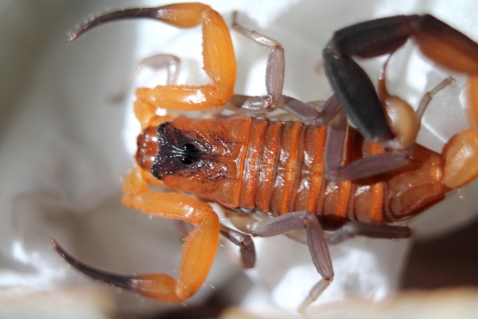
Rhopalurus junceus – Caribbean blue (yes, I know it’s orange)
Other Arachnids:
0.0.1 Damon diadema – Tanzanian whip spider
0.0.1 Paraphrynus carolynae – Sonoran whip spider
0.1.0 Kukulcania arizonensis – Sonoran black hole spider
0.1.0 Kukulcania hibernalis – Florida black hole spider
0.0.XX Loxoceles reclusa – Brown recluse
0.0.3 Sicarius sp. Chile – Sand spider
0.1.0 Heteropoda sp. Red stripe – Red stripe huntsman
0.0.4 Cupiennius salei – Red femur wandering spider
0.2.3 Latrodectus curacaviensis – Chilean widow
0.0.2 Latrodectus elegans – Hellfire widow
0.0.4 Latrodectus geometricus – Brown widow
0.0.11 Latrodectus hasselti – Redback widow
0.2.0 Latrodectus hesperus mexicanus – Western widow (subspecies)
0.2.0 Latrodectus mactans – Southern widow
0.2.2 Latrodectus sp. Mexico – Mexican widow
0.0.5 Latrodectus pallidus – White widow
0.0.10 Latrodectus tredecimgutattus – 13 spotted widow
0.2.8 Latrodectus variolus – Northern widow
1.0.4 Ischnothele caudata – Central American funnel web
0.0.5 Stegodyphus sp. – Social spider
0.0.2 Stegodyphus sp. 4 – Social spider
0.0.1 Geolycosa sp. (missouriensis?) – Burrowing wolf spider
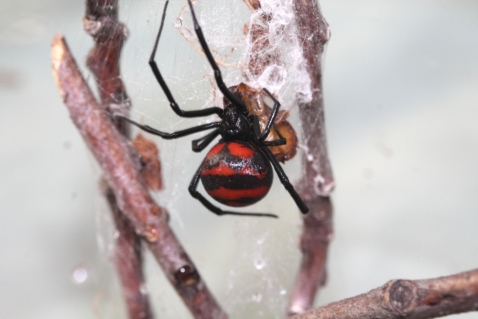
Female Latrodectus curacaviensis – Chilean widow
Insects:
2.2.2 Asbollus verrucosus – Blue death feigning beetle
0.0.5 Arenivaga tonkawa – Arizona sand roach
XX.XX.XX Blaptica dubia – Dubia roach
0.0.7 Blattella asahinai – Asian roach
0.0.19 Blattella nipponica – Japanese field roach
0.0.XX Blattellidae sp. Kenya – Little Kenyan roach
1.1.0 Corydidarum pymgaea – Roly poly roach
0.0.X Diploptera punctata – Pacific beetle mimic roach
0.0.8 Ergaula pilosa – Big black beetle mimic roach
0.0.114 Gyna caffrorum – Chrome roach
0.0.5 Gyna centurio – Centurion roach
0.0.XXX Gyna lurida – Porcelain roach
0.0.XX Oxyhaloa duesta – Red head roach
X.XX.XX Photaelia pallida – Pallid roach
0.6.0 Polyphaga sausseri – Saussere’s giant sand roach
0.0.5 Pseudomops septentrionalis – Pale bordered field roach
0.0.12 Rhabdoblatta formosana – Taiwanese leaf roach
0.0.4 Simandoa conserfariam – Extinct in the wild roach
0.0.15 Therea olegrandjeani – Question mark roach
0.0.XX Therea petiveriana – Domino roach
0.0.1 Platymeris laevicollis – Red spot assassin bug
0.0.2 Platymeris sp. Mombo – Mombo (orange spot) assassin bug
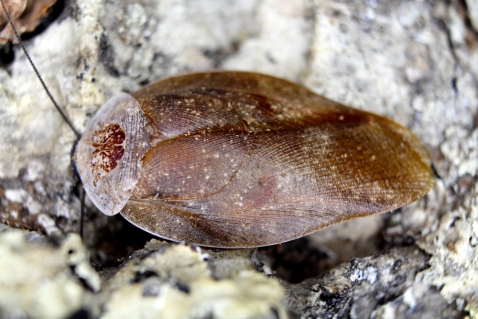
Gyna lurida – porcelain roach
Isopods:
0.0.XX Trichorhina tomentosa – Dwarf white isopods
0.0.10 Oniscus asellus – Skirted isopods
(No isopod pictures at this point)
If there’s ever a show called “Animal Hoarders” I will likely be one of the first people on there! But it’s alright because I absolutely love my collection. I’m hoping to do a string of blog posts highlighting various species so that you all can learn more about the wonderful species found in the invertebrate hobby.
Hope you all enjoyed the post!
2014 in Review
Hard to believe that another year has passed. This has by far been one of the busiest years I’ve had, but I would not trade it for anything. Besides all of the responsibilities of being a graduate student (field work, thesis, being a TA), I managed to travel pretty extensively. I spent three weeks in Kenya collecting ticks with my adviser (posts to come later) and came right back to the US to go on a family vacation to Colorado two days after returning.
Being an avid collector, I tried to get my hands on as many inverts as possible while travelling to all these amazing places, either in photos or in a vial for later pinning/identification. Always looking around yielded specimens I never thought I would obtain, which gives me even more information about an area or even the specimens themselves when I was able to observe them in their natural environments.
The insects were plentiful and the collecting was good everywhere I traveled this year. I could not have asked for more. I have been extremely fortunate and am looking forward to more in 2015.
I could post more, but with the Kenya posts in the works and a nice summary of posts below, I figured I could let you, the reader, decide what you want to read and enjoy the photos that go with each post.
January – tarantulas, bugs in cyberspace, lubbers
February – whites tree frogs
March – things with 8 legs
April – collecting trips and sand spiders
August – Great Sand Dunes National Park
December – keeping live invertebrates, year in review
For those of you on social media, you can follow Insects and Arachnids on Facebook and Twitter:
Facebook: search Insects and Arachnids
Twitter: @damondiadema
I hope you all had a great 2014 and I hope 2015 is even better!
Closing Out 2013
Another year has passed by and boy, has it been a crazy one. I was fortunate enough to get to travel extensively and collect everywhere I went. Photography will be a fun hobby to further pursue as I learn more about taking good pictures and I’m sure I will be able to snap some pretty sweet shots of insects and other natural wonders.
Seeing as my blog is pretty fresh (I only started in October, after all), I can’t really give you a summary of the year, but I can give you the promise that 2014 will have several fun posts that will undoubtedly contain stories, updates, and just all around good buggy times. To 2014!
In Pursuit of Knowledge
While I seem to greatly focus on tarantulas, I have other arachnological and entomological passions. Due to the impending winter (cue sad string music), my posts on insects may become a bit more sparse. Or will they??
I recently got two books in the mail. They are both proving to be good reads thus far and both are fairly recent, so there haven’t been many major changes (yet).
That’s right. I’m going to be getting into breeding arthropods other than tarantulas. The amblypygids, a.k.a. tailless whip scorpions or whip spiders, will be put on the back-burner for now until I get more space and find a mate for the one have now (and figure out how the heck to sex juveniles/sub-adults…). The variety of that order is astounding and I am very much looking forward to that in the future.
My main project will be learning how to breed and rear beetles. I currently have a couple larvae sitting in nice cups of substrate, so I’m playing the waiting game on those. What I’m excited for though, is the new additions that I will likely be coming in next week. I’m getting a sexed pair of samurai helmet beetle (Allomyrina dichotoma) L3 larvae!
L3 means that the larvae is in its third instar, or it has molted twice since hatching out of the egg. Most, if not all, beetle larvae have three instars before they pupate and then eventually emerge as adults. Some species will remain larvae for months or even years (ex. some cerambycids and dynastids). A story that a professor of mine told was about a cerambycid (long horn beetle) larva that remained in a bookcase for decades before it finally emerged one day, giving the family who owned the bookcase quite the shock!
I’ve always been interested in keeping beetles, so this is a fun first step. I’m planning to expand my range next year and collect several harder to find species, along with becoming a bit more specific in what I collect. The only way to start that though is to read, read, read, and for fun, read even more. But it’s winter here, so I’ve got a lot of time on my hands.
Warm Weekends of November
The warmer weekends in November are always such a treat. The sun is shining, the insects are out about (heck yeah!), and I was able to get out to a nearby park to do some dragging for ticks. That’s right. Dragging for ticks. The black-legged tick (Ixodes scapularis) to be precise. This little tick is actually what I’m spending my Master’s thesis working on.
Instead of going to Chicago to visit my field sites, I opted for a more relaxing weekend by dragging at a nearby park that badly needed some exploration (though of course I forgot my camera). The day was perfect and the drive to Kickapoo State Park could not have been better. The winding roads and colorful trees were beautifully peaceful.
I really only dragged at one spot, but it was a spot to remember. To start things off, I went into the woods next to a playground where several small children were playing. Needless to say, they all stopped and stared at me, slightly fearful I’m sure of the strange man walking into the woods wearing a white tick suit and carrying a drag cloth.
Undaunted, I marched into the woods, unrolled the cloth, and started dragging for ticks. It was not long though, before I got distracted and started hunting around for insects. I used some fallen branched to beat trees (no luck) and whenever I checked my drag cloth, I would look at the other creatures that got picked up as well.
Persistence finally paid off though and I got some ticks! I came away with five I. scapularis: one male and four females, though one I will need to look at under a microscope to confirm. But my luck did not stop there. Oh no, I came across some deer scat as well. I took a small twig and poked around a bit, finally coming across what I was looking for.
Recently, I’ve developed a fascination in dung beetles (though not at the same level as other beetle families), so I was hoping to maybe find some under the deer scat, despite it being late in the season. And my luck held out. I found a small species that was undoubtedly a dung beetle. Overjoyed, I poked around a bit more and captured two others as well. If I am lucky, I will get them identified to genus this next week, so I’ll update this post if I figure them out.
Overall, it was a successful day and a beautiful weekend. I am hoping to get a few more days like that before the snows come and central Illinois gets covered with a blanket of white.
What It’s All About
Nature is a passion of mine, but entomology holds a special place in my heart. This is why I’m pursuing a degree in it. In this blog, I want to be able to post thoughts/stories/information about anything nature or entomology related (which you’ll find usually go together quite well). My goal is to post weekly, but it may happen more often, depending on what’s happening (Tarantula Tuesdays sounds like it could be fun…).
I hope you, the reader, enjoy it!
The Switch Over
I was originally posting from a blog call Notice Nature (http://noticenature.blogspot.com/), but the title and the feel just weren’t right, so I’m going to try again here on WordPress with a new title and a new mindset. We’ll see how it goes!
